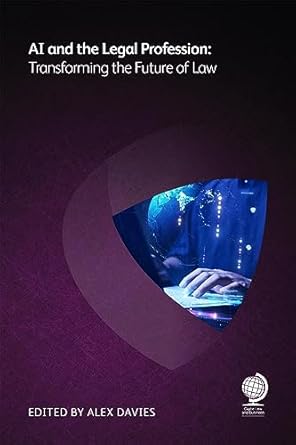Book review: AI and the Legal Profession: Transforming the Future of Law
We review a collection of 11 short essays by industry and legal experts explaining how AI might transform the nature and practice of law. … Continue reading about Book review: AI and the Legal Profession: Transforming the Future of Law

The last couple of years have seen a growing awareness of, excitement about, and anxiety towards, the apparently unbridled potential of artificial intelligence (AI) to change the study, practice, and perhaps even creation, of law. This book by a collection of industry and legal AI experts serves as a good general guide to what AI can and cannot do for the legal profession. Edited by Alex Davies, it’s part of a series about legal tech from Globe Law and Business.
“AI is hotter than the Kardashians, Beyonce, and the Beatles today” writes Cat Casey, chief growth officer of Reveal. So says the hype, but hype has an unfortunately habit of evaporating overnight. Is AI hotter than Taylor Swift? Not today, but maybe tomorrow.
Or maybe it’s just the latest “best thing since sliced bread”. Any rational discussion needs to begin by understanding what AI is and does. Thankfully this book does just that, in Chapter One, where Uwais Iqbal, founder of legal AI consultancy Simplexico, provides a very accessible introduction. As lawyers we know it’s important to define our terms, and Iqbal duly takes us through what all the buzzwords and abbreviations mean, such as natural language processing (NLP), machine learning (ML), generative AI (gen AI) and large language models (LLMs). Then there is the differnce between Horizontal AI (designed for a broad range of use cases and applications) and Vertical AI (focusing on the needs of particular industries or specialisms). He ends his introduction by saying that these are still early days for AI in the legal industry. (Or to put it another way: you ain’t seen nothing yet?)
The next chapter, by Josh Kubicki, from the Center for Computer-Assisted Legal Instruction, considers how preceding new technologies have been greeted, often with initial fear and scepticims and then with routine acceptance. Think of a lawyer’s office now without computers. OK – now think of one without books or paper.
He goes on to consider some of the tasks which AI is already simplifying for lawyers, such as reviewing transactional documents, comparing and streamlining the drafting of contracts, perhaps even providing a first draft of a brief or pleadings. When it comes to negotiations, “AI can analyse past negotiation patterns, predict possible responses, and suggest counter-strategies, allowing lawyers to be better prepared”. It is also well suited to providing summaries of long documents, or compiling a survey of recent developments in a particular area of practice.
In all of these tasks, and in some other possible uses of AI which he goes on to discuss, “AI augments but does not replace human lawyers, combining the best of human insight and judgment with machine capabilities”.
Whether AI will simply augment and enhance, or will ultimately replace human lawyers is the subject of the next chapter, by Sondra Rebenchuk, senior innovation counsel of Blake, Cassels & Graydon LLP. The question is perhaps a simplistic one, she says, because it fails to separate out the different tasks of lawyering. Adopting a more granular approach shows that “many tasks that lawyers perform will continue to be transformed by technology, while others will remain solidly in the human realm”.
She identifies legal research and the ability to surface precedents as an example of something AI is likely to have a big impact upon. Likewise the process of reading and summarising a document, drafting workflows, perhaps even routine emails. What will be critical for lawyers using AI tools is to know how to instruct the AI to perform the task, eg by fine tuning the prompt or query to which the AI must respond. (For all their human like interactions, AI models have shown a tendency to get the wrong end of the stick when fed queries in purely human idiom.)
Other chapters consider matters such as how AI will affect legal education, its effect on privacy and confidential data, its commercial implications, and ethical considerations. Without having read every single chapter, I could not be sure but I had the impression one area it could have covered more generiously was the effect of AI in advancing access to justice, ie the benefit to clients and particularly those who might not afford the swanky law firms whose overheads it may help reduce. (To be fair, Josh Kubicki does mention how intelligent apps and chatbots can provide basic legal guidance to the public and thereby help democratise access to legal services; and there are glancing references to access to justice elsewhere, eg when dealing with ethics.) There is also the difference AI could make to open justice and transparency – for example in providing real time transcription and translation of legal proceedings. (Transparency features rather more in the sense of being able to explain the operation of algorithms or ensure the reliability and lack of bias in the training data for closed box systems.) These topics may well be covered in other books, of course, and it is fair to say that this book is primarily focused on the legal profession and how AI will benefit and/or transform it. It is clear and well written. (It is also – I assume – written entirely by human beings, as is this review.) Let me commend it to the curious.

AI and the Legal Profession: Transforming the Future of Law, by Uwais Iqbal, Josh Kubicki, Sondra Rebenchuk, Cat Casey, Jennifer Leonard, Allison Williams, Nerushka Bowan, Gilad Katzav, Natalie Pierce, Valerie Saintot, Ilona Logvinova, Stephanie Goutos (Globe Law and Business: £149.00 softback and ebook editions.)
Featured image via Shutterstock.